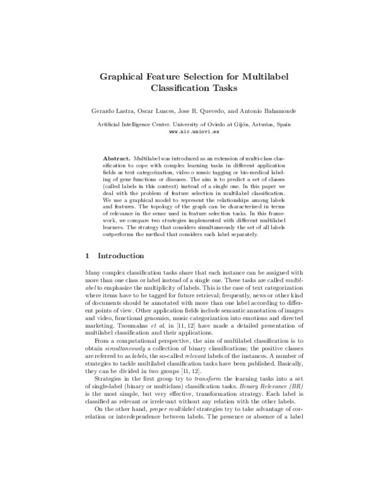Graphical feature selection for multilabel classification tasks
Fecha de publicación:
Editorial:
Springer
Versión del editor:
Citación:
Descripción física:
Resumen:
Multilabel was introduced as an extension of multi-class classification to cope with complex learning tasks in different application fields as text categorization, video o music tagging or bio-medical labeling of gene functions or diseases. The aim is to predict a set of classes (called labels in this context) instead of a single one. In this paper we deal with the problem of feature selection in multilabel classification. We use a graphical model to represent the relationships among labels and features. The topology of the graph can be characterized in terms of relevance in the sense used in feature selection tasks. In this framework, we compare two strategies implemented with different multilabel learners. The strategy that considers simultaneously the set of all labels outperforms the method that considers each label separately
Multilabel was introduced as an extension of multi-class classification to cope with complex learning tasks in different application fields as text categorization, video o music tagging or bio-medical labeling of gene functions or diseases. The aim is to predict a set of classes (called labels in this context) instead of a single one. In this paper we deal with the problem of feature selection in multilabel classification. We use a graphical model to represent the relationships among labels and features. The topology of the graph can be characterized in terms of relevance in the sense used in feature selection tasks. In this framework, we compare two strategies implemented with different multilabel learners. The strategy that considers simultaneously the set of all labels outperforms the method that considers each label separately
ISSN:
Identificador local:
20111638
Colecciones
- Artículos [37549]
- Informática [875]
Ficheros en el ítem




